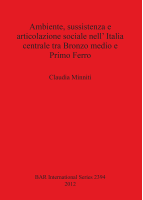Description
BOOK DESCRIPTIONThe present study analyses different faunal samples dated to the Middle Bronze Age and the Early Iron Age from both Latium and Abruzzi (central Italy). It includes a multitude of unpublished material from different sites such as the excavations on the Capitol in the garden of Palazzo Caffarelli in Rome. These sites are particularly interesting for they testify the presence of a long-term settlement along the southern slope of the Capitoline hill as of, at least, the end of the Bronze Age to the Iron Age.Other unpublished samples included are those of the Middle Bronze Age settlement of Castiglione that was partially destroyed at the beginning of the Iron Age by the homonymous necropolis, as well as those from Final Bronze Age settlement of Monte Sant'Elia. It, moreover, includes unpublished samples from the Final Bronze Age settlement of Sorgenti della Nova (and in particular from area Ve); from the Final Bronze Age settlement of Ficana (near the highest and most central part of the aggere that delimitsthe western slope of the plateau); from the Iron Age structure of Fidene; from recent excavations conducted in Rome in the Domus and Velia. The samples from these sites have been compared to those found in different sites in Abruzzi and in particular in the Middle Bronze Age settlement of Cerchio-La Ripa, in the recent excavations of the Final Bronze Age/Initial Iron Age settlement of Madonna degli Angeli and of the Early Iron Age settlements of Punta d'Erce and Tortoreto. This project, that compares archaeozoological data available in literature and the data obtained through direct analysis of sites in the central area of Italy, also seeks to highlight the network of commercial exchanges that characterizes the area of northern Latium, inland Abruzzi andsouthern Latium and that is made traceable by the circulation of metallic artefacts.











